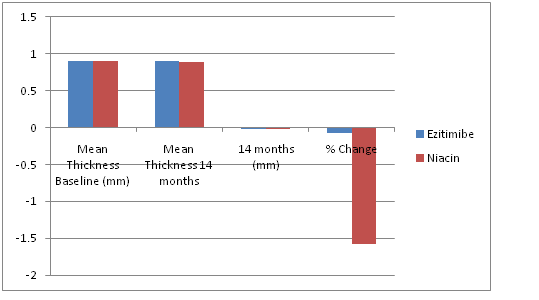Extended-Release Niacin or Ezetimibe and Carotid Intima–Media Thickness (The ARBITER 6–HALTS trial, Taylor et al., NEJM, 11/15/2009): In a recent study, the effect of extended-release niacin (Niaspan, target dose, 2000 mg per day) was compared with ezetimibe (Zetia, 10 mg per day) in a small group of 208 patients with established Coronary Artery Disease (CAD). All these patients had been on long-term Statin therapy.
The primary end point was the between-group difference in the change in mean carotid intima–media thickness after 14 months, using Carotid ultrasound examinations to measure change and compared between the niacin group and the ezetimibe group. .
Results:

Figure 1. Mean Percent Changes in Cholesterol and Triglyceride Levels over the 14-Month Study Period among the 208 Patients Who Completed the Study, According to Treatment Group.
P values are given for the comparison between the two treatment groups at 14 months. The vertical bars indicate the standard errors. HDL denotes high-density lipoprotein, and LDL low-density lipoprotein.
The study was sponsored by Abbott, the manufacturer of Niaspan (niacin extended-release).
Niacin therapy caused a significant reduction in the mean and maximal carotid intima–media thicknesses at both 8 and 14 months. Significant reduction of the mean carotid intima–media thickness was observed in the niacin group between 8 and 14 months (P=0.02). No significant net changes in the carotid intima–media thickness were seen with ezetimibe.

Figure 2. Kaplan–Meier Estimates of the Incidence of a Major Cardiovascular Event among the 363 Study Patients, According to Treatment Group.
The P value, calculated with the use of the log-rank test, is given for the comparison between the two treatment groups at 14 months. The inset shows the same data on a magnified scale.
Major adverse cardiovascular events occurred at a significantly higher incidence in the ezetimibe group (9 of 165 patients [5%]) than in the niacin group (2 of 160 patients [1%]) (P=0.04 by the chi-square test)
Niacin therapy led to regression of carotid intima–media thickness and fewer clinical cardiovascular events over 14 months.An unexpected paradoxical relationship of a greater degree of atherosclerosis progression in patients with larger, ezetimibe-induced reductions in LDL cholesterol level.
The use of ezetimibe led to a paradoxical increase in the degree of atherosclerosis in association with greater reduction in LDL cholesterol.

